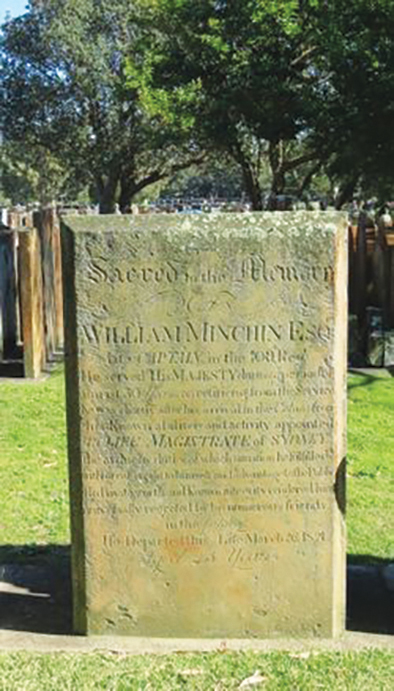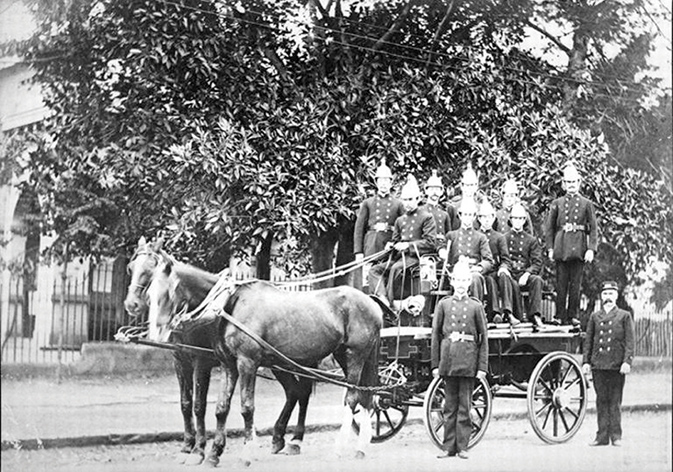Photo of William’s grave courtesy of Find a Grave website.
By Lyn Forde – President/Research Officer of St Marys & District Historical Society Inc.
William Minchin was born in Tipperary Ireland in 1774. He was the son of George Minchin. He was commissioned an Ensign and Adjutant of the NSW Corps in March 1797. He was sailing from Falmouth in England in June 1797 for Botany Bay to take up his appointment in the female convict transport “Lady Shore”, along with his wife Ann. He was also in command of an attachment of troops that included recruits of French and Irish prisoners of war, deserters and prisoners from the “Savoy”. The mutiny aboard the “Lady Shore” in August 1797 was blamed on William Minchin. Second Officer Simon Murchinson writes “Mr Minchin’s bad conduct and want of discipline, made possible the mutiny because he opened two chests of arms. To my astonishment I saw muskets, bayonets and cartridge boxes served to the French and Irish deserters who were put aboard by the guards and posted as sentinels in different parts of the ship”. William, his wife Ann and 27 others were cast adrift and landed at Port St Pedro (Rio Grande) Brazil two days later. On his return to England he was successful in answering charges concerning the mutiny and sailed for Sydney. He took over as adjutant of the regiment from Neil MacKellar in November 1800 and in 1801 he was connected to a duel between Colonel Paterson and John Macarthur and the year after that he became the prime mover in the accusation that Nicolas Baudin was selling at a great profit the rum he brought as provisions for his voyage home and because of this William and Surgeon John Harris were charged and acquitted of lying, however he suffered a loss of confidence by some of his fellow officers. Because of Minchin’s artillery experience Governor King appointed him engineer and artillery officer in 1804, an appointment which involved training the Loyal Associations in the use of the “great guns” and supervised the construction of Fort Phillip. He was promoted to Lieutenant in March 1805. Another highlight in his career occurred in January 1808 when Major George Johnston ordered the corps that were led by Lieutenant Minchin to march to Government House and arrest Governor William Bligh. This incident inspired William to record the scene for the amusement of his friends and he drew a watercolour of old colonial days when he was in the NSW corps of the deposition of Governor Bligh. This picture about 14 inches by 10 inches depicts a red-coated Corporal dragging Governor Bligh clothed in the blue, white and gold of the King’s Navy from beneath a bed. Standing erect, a red-coated Officer dramatically flourishes a sword and commands Governor Bligh to surrender. The drawing is based on William’s evidence given of Lieutenant-Colonel George Johnston at the court martial in May 1811 on a charge of mutiny. A Corporal in the room said, “we found him there sir, and pointed under the bedstead”. William was later sent by Johnston to England with dispatches telling his version of the mutiny. Governor Bligh insisted that William was implicated in the plot to depose him. While in England William was called as a witness by Major Johnston to give evidence on his behalf at the court martial, however, Johnston was found guilty and cashiered from the corps. At this time, Provost-Marshal Gore of Sydney now in London was giving evidence for Bligh and began legal proceedings against William for his share in the rebellion against Bligh. William appealed to Lord Liverpool to restrain Gore on the grounds that he had acted under the orders of his superior officer Major Johnston. His plea was successful and he applied for the position of Captain in the Royal African Corps but he was unsuccessful as there was no vacancy, so he accompanied his regiment to Guernsey and to Bermuda where they arrived in September 1811, two days prior to this he had been promoted to Captain. He fought in small skirmishes during the American war in 1812-14 and in September 1813 the regiment moved to Halifax then it was moved to New Brunswick in 1816 where his brother George (who was later a member of its Legislative Council) was living. In August 1817 William retired and sold his commission and in September 1818 he returned to Sydney with his wife and daughter Maria Matilda. His fellow officers Johnston and Paterson had granted land to William and Ann but Governor Macquarie cancelled both these grants, but in 1819 Macquarie did grant William 1,000 acres, part of which was to be the “Minchinbury” estate. Governor Macquarie appointed him principal Superintendent of Police and Treasurer of the Police Fund in April 1820 after D’Arcy Wentworth. He also became a Director of the Bank of NSW and a member of the Bible Society and was also appointed a member of the Male and Female Orphan and Native Institutions. William died after a short illness on 26th March, 1821 aged 45 and is buried at Devonshire Street Cemetery He left his property to his daughter Maria Matilda. His widow Ann married Eber Bunker and died in 1837 aged 61 years and is also buried at the Devonshire Street Cemetery. His daughter Maria Matilda married Henry Howey in 1826. The Howey family were drowned in the loss of the “Sarah” in 1838. Because of this tragedy there was no heir and the property was purchased by Dr Charles McKay in 1859.
Source – Historical Records of NSW, Historical Records of Australia, Court Martial Trial of George Johnston (London 1811), Army letter book 1816 (Legislative Library, New Brunswick), Manuscript catalogue under William Minchin in State Library of NSW, Blacktown City Council Library, Local History section Australian Dictionary of Biography – Volume 2 , 1967, Ancestry.






